|
|
|
This information on the Monro family in New Zealand has been presented by Peter David Monro (as a retirement project at age 63) based on his records and memories of his lifetime.
| This photograph taken in 1937 when Ann was a babe in arms on her Mother, Jean's (nee Watts) knee. Standing is Jean's Mother in law Catherine (nee Nicholls) and seated is Catherine's mother Lillie Gundry aged 84 years. This photograph is from Jean (neeWatts) album passing to Peter Monro on her death. |
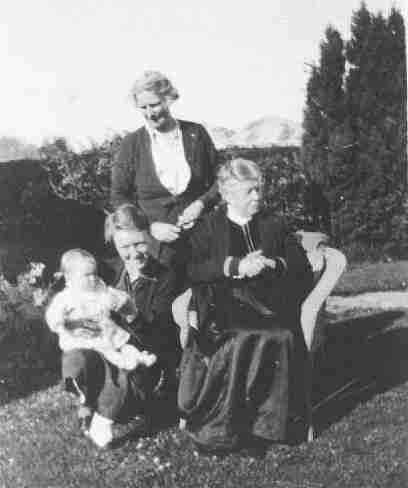
|
The Monro Family in New Zealand in its formation years of the early 1800’s was from two families closely
related.
The first family was that of Sir David Monro the fourth son of Professor Monro Tertius who arrived in
New Zealand in 1842.
This family in New Zealand is reported in the publication "Doctors Monro" by
R.E. Wright-St. Clair. Peter Monro and David Barker both have a copy of this book. Other copies are held by
the Auckland City library.
The second family is from Harriet, Sir David's sister. Alexander Binning Monro and George Home Binning Monro
both emigrated to New Zealand where their father had bought land from the New Zealand Company. These two are also
reported in the publication above.
In 1857, Alexander Binning took passage of the barque Creswell arriving in Nelson New Zealand 111 days later on
February the 6th 1858. He was 19 years old. He was one of 16 first class passengers and there were a further 34 in
steerage. With him on this voyage were Charles and Thomas Cotterell later to become his relatives. The Creswell, at
500 tons, was small but sailed directly to Nelson so saving the time of transhipment from a larger vesselwhich
would not be able to enter Nelson harbour.
On 10 June 1859 George sailed from Great Britain in the Alpine. The Alpine arrived in Port Otago on Sunday the
11th September with immigrants. She left the Clyde on the 10th June with upwards of 500 souls on board, and passed
Eagle Island the following day. Light winds and fine weather were experienced for the first six weeks of the passage,
and the Equator was crossed on the 24th of July. The meridian of the Cape was passed on the 7th of August. On the
24th the iron reefing gear of the main topsail yard was carried away, which prevented any sail being set on the main
yards for three days, during which the accident was repaired. Off the coast of New Zealand spoke the "Mato-aka,
" bound for Auckland. Made the Snares (65 miles SSW of Stewart Island) on the l0th September, and on the next day
anchored at Otago, after a fair passage of 93 days from land to land, during which no very heavy weather was
experienced, nor anything calling for more special remark. The Alpine is one of the finest ships that has ever
anchored in Port Otago The cabin passengers on the " Alpine,"previous of their arrival in harbour,
presented an address to Captain Crawford expressing their gratitude. G.H.Binning Monro added his signature, Things
did not go so well for the immigrant passengers below deck. Eight children passengers died during the passage and
an adult with consumption. The Immigration officer in Dunedin charged the master with breaches under the "
Passenger Act 1855" of single men to be berthed in separate compartment, number and sex in one berth, construction
and privies, light and ventilation, certain articles prohibited as cargo and ballast and storage of cargo, water
and provisions, size of messes and issue of cooking provisions,
Passenger cook and cooking apparatus, Medicine and medical comforts,
sale of spirits. Then George had to wait in Port Otago 13 days until
the coastal steamer Prince Alfred called to take him to Nelson
arriving there on 1st October 1859.
The text relating to George
Home Binning is derived from Sir David's diaries which are held by
the Nelson Provincial Library. Copies of the diaries (as microfilm
for the years 1868 to 76) are held in the National Library in
Wellington. These are available on interloan in Auckland but I have
purchased a copy of it from which a transcription has been made and
sent to the National library and the Nelson Provincial Library . The
records of George which follow are but a summary of the information.
The full script comprises many pages which can be viewed . A link has
been provided so that you can read some of the script if you choose.
A full copy is held by the National Turnbull Library in Wellington
George married Isabella Selina Baldwin from Stede Hill, Kent, England. A detailed account of George and Isabella's life can be viewed on this link
|
Isabella had 6 brothers and 3 sisters. Her father died in
1866. She took passage on The Pleiades which sailed from Greenhithe
in the Thames on September 12th 1872 and was expected to take about
100 days to reach New Zealand |
|
The early history of the Stede family can be seen by clicking
this link
to Stede website
The Stede and the Baldwin family history are
detailed in the publication by Robert. H. Goodsall Stede Hill: The
Annals of a Kentish Home, (Headley Brothers (109 Kingsway, W.C.2),
London, 1949). A copy of this book is in the library folder on this
CD. David Barker has a copy of this book. One can be obtained on loan
from the National Library in Wellington (their reference 731815).
William Horsmonden Turner purchased Stede Hill from Edwyn Stede
when he became insolvent in March 1725. On his death the property
transferred to Charles Booth.
When Charles Booth (High Sherrif of
the county) died in 1776, William Baldwin (Isabella's grandfather)
inherited Stede Hill (which for a time had been known as Harrietsham
Place) from Sir William Horsmonden Turner. William Baldwin died on
9th October 1839 in his eighty fourth year and was burried in Stede
Chapel of the Parish Church.
In consequence, William Wriotheseley
Turner Baldwin, his eldest son, (Isabella's father) became the owner
of Stede Hill house and estate. Understandably in the months which
followed, the new squire was much occupied with the many legal
formalities which arose from his fathers death, an occupation to
which the contents of his letter -book bears witness, including
donation of land for a school. He died in 1866 and 6 years later
Isabella left for New Zealand.
George and Alexander farmed or
managed their father's land in the Wairau valley south west of
Blenheim. The farms were administered by Sir David on their father's
behalf with the two trading as Monro Brothers. They eventually became
insolvent. George and Bella had five children of which their third
son, Charles George married Catherine Nichols
When George died in
1885 Isabella was 35 years old with 5 young children. The eldest son
Alexander returned to Scotland and Isabella remarried John Dow Busby,
son of James Busby the first New Zealand Resident who was then living
in what is now the Treaty House at Waitangi.
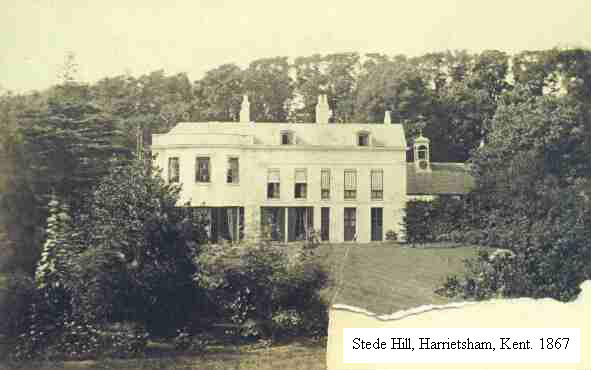
|
The picture at right is from Jean Tanner's collection held by P Monro. The picture shows the East wall containing the library, billiard room and drawing room. The south wall and west wall are much longer giving a much larger building than appears in the picture. There was also a large barn on the northern side forming a partly enclosed courtyard. |
Charles
Charles George Monrowas born on 8th July 1878 when his mother, Isabella Selina, was twenty eight years old and his father George Home Binning was thirty seven. They were at the Valley field sheep run at Omaka some 25km South west of Blenheim. His Birth registration No 1880 420 in the district of Wairau, shown herein shows an apparent error in his name. One could expect that this is his brother's birth certificate. However the covering letter from the registrar states" I have to advise you that a search of the records fails to reveal an entry under the name "Charles George" but that the certificate supplied appears to refer to you. |
|
|
This photograph stood on his desk for as long as his daughter Jean could remember. Presumably it is a photograph of his mother. |
|
He married Catherine Nichols on 21st December 1905 or perhaps the 23rd so Jean says. She probably moved to Woodville with her family in June 1891 because this is when her school attendance record starts there. However her attendance was intermittent. Her father was Postmaster in Masterton in 1904.
|
|
This is Catherine nee Nichols |
The photographs of them in their house in Clonburn Rd Auckland are enclosed.
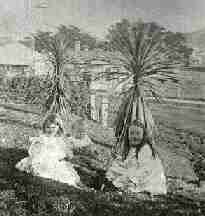
|
This picture of the three children is probably of Jean, Agnes and David. The house in Clonburn Road remained in this condition until about 2000 but has since been demolished. David tells of how,on race days, he used to sit on the gate posts (probably the same ones in the picture background) and yell cheeky comments to the Maori driver of the horse drawn cabs as they drove their passengers to the races. The drivers responded by cracking their whips at them. |
|
This photograph of Charles and Catherine on the front steps with the three children. |
|
Charles was having difficulty earning a living as an architect so the family eventually moved to Te Kuiti where Charles had acquired some farm land. The family stayed in the town. David used to travel on horesback in the weekends with his father to the farm where they lived in a bush camp under canvas.
Unfortunately the venture occurred during the depression. It was a failure and in1922 they lost the farm. David had to go to work in a drapery shop because of the shortage of money and Bill had to go to Dilworth School. This would be around 1925 when David was 15 years old. The failure at the farm was a blow. Catherine went to the Bay of Islands. How it effected each family member is arguable. David never talked of it . Bill regretted his time at Dilworth to his deathbed. Perhaps Mary's poor health and Nessie's isolation was a consequence However to all appearances, Jean, David and Helen battled on.
Aunty Jean told me somewhere along the line that her father had to go on the farm because when the war started there was no work for him as an architect. He had qualified at Dover University. I suspect that poverty became too much for his wife. He just didn’t have what it takes to be a business man. Ann had a letter from Aunty Jean somewhere about how he was a great inventor and invented a repeating rifle, and sent it off to be patented. It was gone a very, very long time and finally came back from the Govt. that they (The Govt.) had already invented the same thing – sorry!! Apparently the mother was furious, but he had no idea what to do, if anything. Maybe we could sue the Govt. for royalties after all these years – who knows Judith Berry
Some time later Charles and Catherine settled in Masterton. The house at 1 King Edward St, Landsdowne was large much like a Villa with central corridor,dark and paneled and rooms each side.
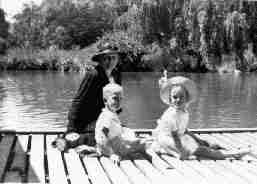
|
Ann and Peter visited their Grandmother on several occasions. This picture taken in Masterton in 1942 |
In the late 1940's Catherine after a long illness died. Charles continued his work as an architect and died arround1950. Both are buried in Masterton
Catherine Jean (called Jean) was the eldest of the children. She was a spirited woman much in keeping with her Galic heritage. She married Ernest Tanner and bore 2 children, Margaret and Esther. They lived in Napier until divorced in the 1950's. In her later years she became a companion to geriatric men who needed home care. On the death of one of her companions around 1975 she bought a small van and toured the North Island for several weeks. She finally moved to Himatangi where she lived for several years before her death. She gave me some of her treasures including the photographs of Clonburn Rd, one of Charles" shooting trophies, the photograph that sat on Charles' desk, eight Hall marked silver teaspoons some from the Nicholls side. Others were from Aunt Louisa, sister of J.S.Busby. She also gave me an impressive sugar bowl and tongues and the book "Doctors Monro". These are shown in the museum.

This picture of Jean shows her visiting her grandparents grave at the old Gonville cemetery in Wanganui. Also buried there is her Aunt Ada who died young.
|
|
These two pictures of Ada taken in 1911 are from Jean's collection now held by Peter Monro. |
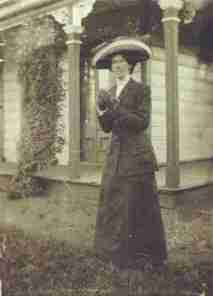
|
Agnes was not closely associated with her family during her lifetime. She marred a judge of the Moari Land Court and did not appear to relish association with her brothers.
David was the eldest son in Charles and Cathrine's family. He was born on 31st October 1910 in Masterton. Birth certificate No. B1743. Why he was born in Masterton whilst the family appears to be living in Clonburn Rd is a mystery. Perhaps Catherine chose to be near her family for the birth.
When his parents lost their farm his education was terminated and he was forced to seek work. He started in the local drapery store and then got employment with the Post and telegraph department with the following record:
He passed University Entrance Examination in 1934 in English(50%) Mathematics (53/59/63), Latin
(34%),geography(48%) and drawing(57/37). He also trained in boxing and wrestling. He had an impressive
physique standing at 1.85m tall
He married Jean Bremner Watts (borne
8th January 1913) only daughter of Henry Watts and Anne Catherine
McLean of Wellington at St Georges Church, Epsom on 9th May
1936.(Certificate No.24154). Jean had a Bachelor of Arts degree and
played the piano. She was living in Tamaranui at the time probably
working as a school teacher. Their first child Ann Margaret was born
on 9th January 1937. Peter David was born on 9th March 1938.
The family was at this time living in Auckland in a state house in Handley Ave on the North Shore. Here he and a friend built a frostbite sailing dinghy. However with the war looming and the location of the home near the naval base and under the coastal defense guns they decided it was time to move and they relocated to Paeroa.
Although he was
medically unfit for military service(foot archers I believe), he Joined
the third division of the Armed Forces 28th January 1942. He had been
exempted from the first two divisions by a young family but with
Japan entering the war he was needed. Jean says he got fed up with it pretty quick.
They landed in August and September, 1943, on Guadalcanal, that island was the
principal forward American base for actions in progress 200 miles
away to the north in the New Georgia group. Guadalcanal was still
within range of Japanese bombers from Vila, on Kolombangara, and
other, enemy-held airfields further north on Bougainville and the
Shortlands. Bombers came nightly, dropping their bombs on dumps,
shipping, and airfields. Guadalcanal had been won, but the Solomons
campaign was at its peak.
The Japanese had been driven to the
northern end of Vella and the New Zealanders had to complete the job
by cleaning them up or cleaning them out altogether. They did it in
admirable style, quickly acquiring the difficult and dangerous art of
jungle warfare. By day the jungle is comparatively quiet, but when
night falls, the jungle comes to life and bedlam reigns till dawn.
This was the setting for the 14th Brigade's first action and, with
few exceptions, for all jungle action. In such a setting the
New Zealanders completed their task of ousting the enemy from Vella.
There were many gallant actions as of officers observing for
artillery who crept, through the jungle in front of infantry patrols
to watch and listen where the shells fell, for it was impossible for
the gunners to see their targets and the results of their fire.
Sometimes these officers lay from 25 to, 50 yards from the bursts.
Proofs of their efficiency came later when mutilated trees and pitted
earth presented a vivid example of what flying fragments of metal can
do, even in the jungle. And the Japanese did not like artillery fire.
Then there was the work of the signallers with radio and cable, the
engineers who made roadways and airstrips, and, above all, the air force.
He was discharged from the Army on 13th June 1944 as medically unfit after 328 days of service in New Zealand and one year and 143 days overseas. (Certificate No 8457) . His war service medals which are in my possession are:
On his return from the war he became eligible for a Government grant which would enable him to buy a house or farm. He first tried farming with Otto Bjering near Waihi Beach. The family lived with Otto who lived alone in the farm house which did not have electricity. Consequently in the evening all was done by candle light or occasionally the tilley lamp was lit. The children went to School in Waihi on the school bus. They had to dismount from the bus to cross unsafe bridges. After a few months the family moved a few miles to work for Gerald Hazard where the accommodation was several leaky, rat infested Nissen Huts but electricity was available. After a short while they decided that farming was not for them and they purchased a house in 29 Ngaio St., Palmerston North.
David rejoined the Post and telegraph on 1st October 1945 and was promoted to Examiner on 1947.
Judith Mary was born on the 5th January 1945.
|
|
He resigned his position with the Post and telegraph on 3rd October 1951 to take employment as a clerk in the Army at Linton Camp. |
Shortly after moving to Palmerston North, He commenced studying for Accountancy examinations and obtained them 10 years later in 1954 both ARANZ and ACIS. Although he was then only 44 years old he felt that he had acquired the qualification too late in life to be of great benefit.
He made several improvements to the house. He removed the old wood fired copper and concrete tubs and extended the kitchen into the wash house. The garage was also extended to provide a workshop and around 1955 they purchased an old Chevrolet car from Arthur Parkin a neighbor across the road. Much of the wooden coach work and the canvas roof he replaced along with numerous repairs to the engine. A photo of a 27 chev in excellent condition is below. Ours was not in such a fine state but ran very nicely.
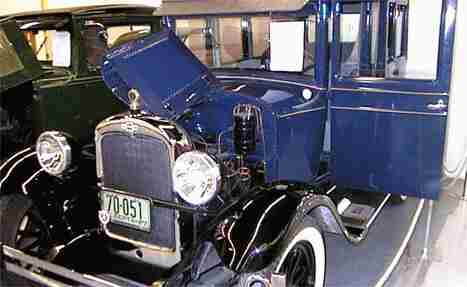
Jean got a new automatic washing machine and carpet for the lounge and hall.
|
|
After a year or more the Chev was sold and replaced with a Morris series E which was a bit more modern. From left to right Peter, David ,Judith,Jean |
He was discharged from the Army on 8th May 1958 to take up a position as Government Auditor.
In 1960 they moved to Rothesay Bay in Auckland's northern Suburbs where they purchased a house in 43 Churchill Rd overlooking the beach. This was just after the opening of the Harbour Bridge which made commuting to the city by car or bus, a practical form of transport. In subsequent years he excavated under the rear of the house and built a small extension (with all his own labour and design) to form a sun room. Whist undertaking this work he managed to remove a couple of fingers in the circular saw.
He had a mild heart attack in 1961 that aged him overnight.
He retired from work in 1964,on Government superannuation, after 40 years service , at the age of 54 but was able to get part time work at the Council offices in Browns Bay.
In 1973 they found the bay too noisy. They sold the Rothesay bay home and moved north to Keri keri. A move they very much enjoyed. One day whilst playing golf he had a coughing fit which turned out to be lung cancer. He had been a smoker most of his life but stopped smoking some ten years previously when he had his heart attack. He had radiation treatment but he could see his time was coming and Jean, not wishing to live by herself in Keri keri, they returned a year later to Auckland purchasing a home unit in Glenfield.
He died on 16th July 1977 in the Public Hospital Takapuna at the age of 66 years form Widespread Metastatic deposits during 1.5 years and lung cancer in the right lung for 2 years. He was given Requiem Mass and buried in the North Shore Lawn Cemetery at Schnapper Rock Road.(Certificate No 34509)
Jean lived on until she was diagnosed with pancreas cancer. She had surgery to provide a bypass but died in Hastings in March 1984 where she had gone to live with her daughter, Ann. She was buried with her husband in the North Shore Lawn Cemetery.
Helene was married 3 times yet had no children. Her second husband died. Her third husband was Alf Nicholls They adopted 2 children Mary and a John who was occasionally in trouble with the law. Alf's relatives owned waterfront land at Bay View north of Napier. There was in the late 1940's, a small bach on the beach front which they occupied.
Helene died quite young from Cancer. She was cremated at West Auckland Crematorium on the great North Road.
Known as Bill was borne about 1919. During the depression his parents were unfortunate to lose their farm. Consequently Bill was sent to Dilworth School in Auckland which provided an education for children in his circumstances. He was aged about 7 years at the time. He hated it but became the school swimming champion with his name on the School Honours Board unfortunately spelt incorrectly
About 1940 he was in the Air force in Canada training as a fighter pilot. He was at the cessation of the war flying Spitfires
On his return to New Zealand he settled in Palmerston North where he purchased a house in Anandale Ave. He married twice. He had a son Alister with his first wife Alison Seifert but when they separated the boy went with her and they had little further contact. Alister graduated with a degree in geology and at the onset of the mineral exploration boom went to Australia. His second wife Joyce bore him a son, David.
Bill worked all his working life with the Government mainly in the Insurance Office where he was a clerk. He did not have any career ambitions. He was very careful with his money. It could not be said that he was poor. Perhaps frugal. It is likely that this frugality was a consequence of his poverty in his formative years. In 1955 he purchased a new Austin mini minor car. This at a time when cars could only be obtained with overseas funds, the purchase of a new car was normally only possible by the wealthy. However it is probable that he obtained the money from a small inheritance as did his elder brother David at this time. He also had the best in cameras, and stereo equipment with a great liking for Bach and his Brandenburg Concertos. All this at the expense of furniture and household equipment and fashionable clothing. On the weekends he would take David for a car ride that could be had at 1 hour duration. Trips were to to the mountains and Kapati Island.
He died in Palmerston North in 2000 from prostate cancer but was active and sound minded to almost the end. The car was in active use at this time.
Mary married Charlie Ross on 26th June 1848 at the Holy Trinity Church, Avondale, Christchurch They had two children, Rosemary and Paul. The children lived for a short period in the late 1940's with David and Jean when there were problems in the family.